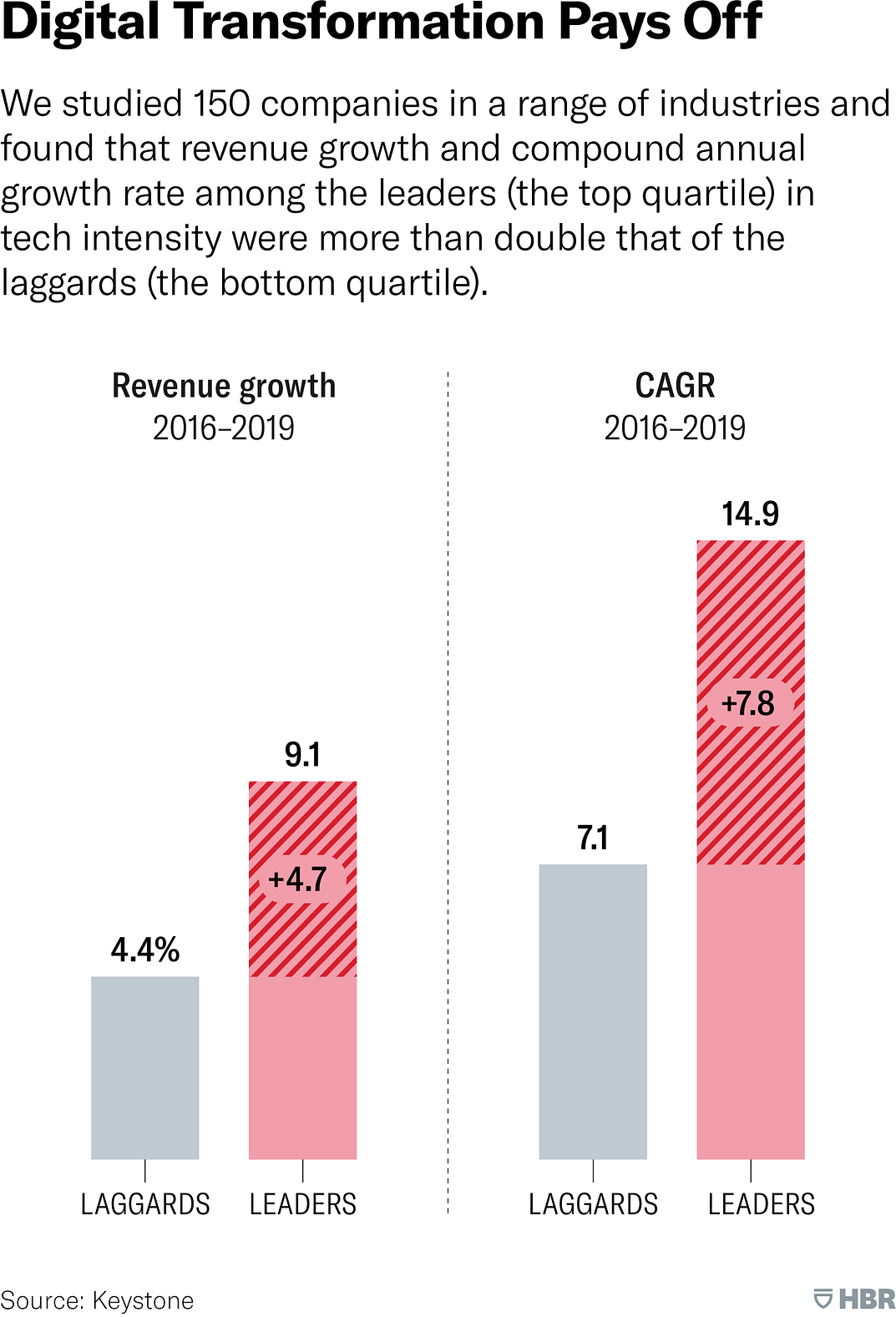This is a republication of the article below, with the title above, with a focus on the topic in question.
Democratizing Transformation — The case of Novartis and Microsoft
And the results of a 150 organizations survey
Harvard Business Review
by Marco Iansiti and Satya Nadella
From the Magazine (May–June 2022)
Summary.
Many companies struggle to reap the benefits of investments in digital transformation, while others see enormous gains. What do successful firms do differently?
This article describes the five stages of digital transformation, from the traditional stage, where digital and technology are the province of the IT department, through to the platform stage, where a comprehensive software foundation enables the rapid deployment of AI applications.
The ideal is the native stage, whose hallmarks are an operating architecture designed to deploy AI at scale across a huge, distributed spectrum of applications; a core of experts; broadly accessible, easy-to-use tools; and investment in training and capability-building across the enterprise.

Over the past decade, Novartis has invested heavily in digital transformation.
As the Swiss pharmaceutical giant moved its technology infrastructure to the cloud and invested in data platforms and data integration, it recruited AI specialists and data scientists to build machine-learning models and deploy them throughout the firm.
But even as the technical teams grew, managers from across the business-sales, supply chain, HR, finance, and marketing-weren’t embracing the newly available information, nor were they thinking much about how data could enhance their teams’ work.
At the same time, the data scientists had little visibility into the business units and could not easily integrate data into day-to-day operations.
As a result, the investments resulted in only occasional successes (in some aspects of the R&D process, for example) while many pilots and projects sputtered.
… managers from across the business… weren’t embracing the newly available information, nor were they thinking much about how data could enhance their teams’ work …
…the data scientists had little visibility into the business units and could not easily integrate data into day-to-day operations.
… the investments resulted in only occasional successes (in some aspects of the R&D process, for example) while many pilots and projects sputtered.
More recently, however, pilots targeting both R&D and marketing personalization started showing business value and captured the attention and imagination of some of Novartis’s more creative business executives.
They became increasingly excited about opportunities to deploy AI in various parts of the company and began to earnestly champion the efforts. (Disclosure: We have both worked with Novartis and other companies mentioned in this article in a variety of ways, including board membership, research, and consulting.)
They realized that technologists and data scientists alone couldn’t bring about the kind of wholesale innovation the business needed, so they began pairing data scientists with business employees who had insight into where improvements in efficiency and performance were needed.
More recently, however, pilots targeting both R&D and marketing personalization started showing business value … they began pairing data scientists with business employees
Novartis also invested in training frontline business employees to use data themselves to drive innovation.
A growing number of teams adopted agile methods to address all kinds of opportunities.
The intensity and impact of transformation thus accelerated rapidly, driving a range of innovation initiatives, including digitally enabling sales and sales forecasting, reconceiving the order and replenishment system for health-care-services customers, and revamping prescription-fulfillment systems and processes.
The progress in digital transformation became invaluable as the company dealt with the initial chaos of the pandemic.
Novartis business teams partnered with data scientists to devise models to manage supply-chain disruptions, predict shortages of critical supplies, and enable quick changes to product mix and pricing policies.
They also developed analytics to identify patients who were at risk because they were putting off doctor visits.
As the Covid crisis wore on, the value of AI became obvious to managers companywide.
Before this wave of AI adoption, Novartis’s investments in technology consisted almost entirely of packaged enterprise applications, …
… usually implemented by the IT department with the guidance of external consultants, vendors, or systems integrators.
But to build companywide digital capability, under the leadership of then chief digital officer Bertrand Bodson, Novartis not only developed new capabilities in data science but also started to democratize access to data and technology well outside traditional tech silos.
The company is now training employees at all levels and in all functions to identify and capitalize on opportunities for incorporating data and technology to improve their work.
In 2021, the Novartis yearly AI summit was attended by thousands of employees.
… Novartis not only developed new capabilities in data science but also started to democratize access to data and technology well outside traditional tech silos.
The potential for employee-driven digital innovation is impossible to calculate, but according to the market research firm IDC’s Worldwide IT Industry 2020 Predictions report, enterprises across the global economy will need to create some 500 million new digital solutions by 2023-more than the total number created over the past 40 years.
This cannot be accomplished by small groups of technologists and data scientists walled off in organizational silos.
It will require much larger and more-diverse groups of employees-executives, managers, and frontline workers-coming together to rethink how every aspect of the business should operate.
Our research sheds light on how to do that.
IDC predictions are that … enterprises across the global economy will need to create some 500 million new digital solutions by 2023 -more than the total number created over the past 40 years.
This cannot be accomplished by small groups of technologists and data scientists walled off in organizational silos.

The Success Drivers (excerpt)
Our research shows that to enable transformation at scale, companies must create synergy in three areas:
1.Capabilities.
Successful transformation efforts require that companies develop digital and data skills in employees outside traditional technology functions.
These capabilities alone, however, are not sufficient to deliver the full benefits of transformation; organizations must also invest in
- developing process agility and,
- more broadly, a culture that encourages widespread, frequent experimentation.
2.Technology.
Of course, investment in the right technologies is important, especially in the elements of an AI stack: data platform technology, data engineering, machine-learning algorithms, and algorithm-deployment technology.
Companies must ensure that the technology deployed is easy to use and accessible to the many nontechnical employees participating in innovation efforts.
3.Architecture.
Investment in organizational and technical architecture is necessary to ensure that human capabilities and technology can work in synergy to drive innovation.
That requires an architecture-for both technology and the organization-that supports the sharing, integration, and normalization of data (for example, making data definitions and characteristics consistent) across traditionally isolated silos.
This is the only real, scalable way to assemble the necessary technological and data assets so that they are available to a distributed workforce.

Building Tech Intensity (excerpt)
Our research unpacks how capabilities, technology, and architecture work together to build what we call tech intensity.
(See the exhibit “Digital Transformation Pays Off.” To score your firm’s tech intensity, go to www.keystone.ai/techintensity.)

We also found that technology, capability, and architecture indices correlated with other measures of performance, from productivity and profits to growth in enterprise value.

Staging the Transformation (excerpt)
Our analysis confirms that just spending money on technology does not result in more growth or better performance; in fact, in some cases it can actually damage the business if it accentuates divisions and inconsistencies across groups.
Instead, it is the architectural, managerial, and organizational approaches to transformation that best explain the substantial and enduring differences among firms.
We found that companies typically progress through five stages on their transformation journey.
- Traditional model.
- Bridge model
- Hubs Model
- Platform model
- Native model
The Imperative for Leaders
The mandate for digital transformation creates a leadership imperative:
- Embrace transformation, and work to sustain it.
- Articulate a clear strategy and communicate it relentlessly.
- Establish an organizational architecture to evolve into as you make the myriad daily decisions that define your technology strategy.
- Deploy a real governance process to track the many technology projects underway, and coordinate and integrate them whenever possible.
- Champion agility in all business initiatives you touch and influence. And finally, break free of tradition.
- Train and coach your employees to understand the potential of technology and data, and release the innovators within your workforce.
This mandate extends to technology providers.
Despite much investment, technologies are still too complex and are often too hard to use and deploy.
We need tools and technology that make driving transformation intuitive for frontline workers while keeping data secure.
Let’s not forget that until recently many of us were relying on specialists in Fortran and Cobol to model business problems and even to perform basic mathematical operations.
Spreadsheets brought about a revolution in mathematical modeling; we need technology providers to bring the same revolution to AI and make using a machine-learning application as easy as creating a pivot table.
Momentum is growing. But we must sustain the efforts to ensure that companies of all stripes make it across the digital divide.
A version of this article appeared in the May-June 2022 issue of Harvard Business Review.
Originally published at https://hbr.org on May 1, 2022.

Idea in Brief
The Problem
Many companies struggle to reap the benefits of investments in digital transformation, while others see enormous gains. What do successful companies do differently?
The Journey
This article describes the five stages of digital transformation, from the traditional stage, where digital and technology are the province of the IT department, through to the platform stage, where a comprehensive software foundation enables the rapid deployment of AI-based applications.
The Ideal
The ideal is the native stage, whose hallmarks are an operating architecture designed to deploy AI at scale across a huge, distributed spectrum of applications; a core of experts; broadly accessible, easy-to-use tools; and investment in training and capability-building among large groups of businesspeople.
TAGS:
Digital Capabilities; Digital Technology; Digital Architecture; Key Success
About the authors
Marco Iansiti
David Sarnoff Professor of Business Administration,is a codirector of the Laboratory for Information Science at Harvard and of the
Digital Initiative at HBS.
Satya Nadella
Chairman and CEO at Microsoft
Names mentioned
Chief digital officer Bertrand Bodson, Novartis;
Eric von Hippel of MIT;
Victor Bulto, Novartis’s head of U.S. pharmaceuticals;
Lori Beer, JPMorgan Chase’s global CIO,
CEO Kevin Johnson, Starbucks












